
The benefits of technology are undeniable, but as we foster our young child’s educational experience, we must decide how much technology the child becomes exposed to at a young age. As technology use grows in public schools, consider the benefits of a tech-free kindergarten classroom, similar to options found at various Montessori schools.
Learn how a tech-free class will benefit your child at a young age and the positive options that come with a tech-free class.
1. Motor Skill Development
Apps and touch-screen devices provide ways for children to learn skills like math, but children will process learn motor development skills when completing activities in real-time. For example, if a child counts balls on a screen, they are not physically lifting the balls and sorting them into different areas.
The physical touch helps develop fine motor skills and allows a child to naturally grow their fine motor skills. Instead of computers or tablets for learning, a child may use hands-on objects like scissors. By using motor skills, a child also has time to process more. They are counting and sorting real objects in the physical world. A brain processes the objects easier.
Each day, kindergarten students learn how to use various objects. Play items like sand or dough also help a child explore their fine motor skills while creating a sense of fun and imagination.
2. Socialization
When a student spends time on a computer or tablet, the student is typically isolated in their learning, even if they sit right next to another student. Real-world learning allows students to function and engage with each other while building social skills.
Students will learn how to interact, engage in conversation, and properly get through conflict. With time dedicated to screens, students are limited in social engagement with both students and teachers.
3. Screen Time Limits
Years ago, children’s access to technology was limited. Some homes did not have a computer while a school provided the computer access needed. Now, children have screen time access through televisions, tablets, phones, and computers. When a student spends a lot of time outside the classroom on screens, you do not want to worry about even more screen in the class.
When you send your child to a tech-free classroom, you know they will have a large portion of the day without the use of screens. The World Health Organization recommends no more than an hour of screen time each day for many kindergarten-aged children.
By sending a child to a tech-free classroom, you will help limit their exposure to screens and easily track the hours the child has spent on a screen. The limits will allow a child to thrive, build their imagination, and come up with creative ways to play.
4. Sensory Control
Exposure to screens includes a lot of sensory exposure. In just one app, a child could see quick-cut animations, loud sounds, constant music, and bright visuals. With a tech-free classroom, a child does not become overly stimulated in the classroom environment.
When a child is overstimulated, they could become upset and stressed out. You may notice an increase in anxiety in the child. A traditional Montessori classroom eliminates devices and objects which may cause too much stimulation. The lack of sensory overload will help a child focus, learn, and process through different educational elements.
Along with apps and tablets, the same sensory overload could occur when watching movies or television shows. A tech-free classroom eliminates all of the sensory options and allows you to make screen time decisions for your children at home.
For more information on our classroom environment, contact us at Miniapple International Montessori School. Learn about our classrooms and ways we engage your children without the need for tech devices.

